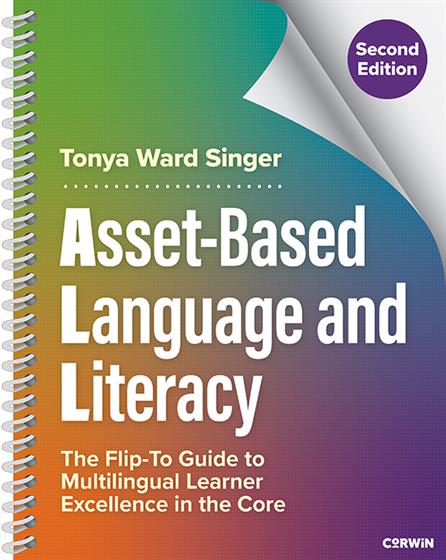SECTION I: ESSENTIALS FOR MULTILINGUAL EXCELLENCE
1. INTRODUCTION
Equal Access to Academic Excellence
Every Teacher an ML Teacher
Six Essentials for Equitable Impact
Teaching and Leading Beyond the Labels
Practical Ways to Use This Book
2. ESSENTIAL MINDSETS
Mindsets Matter
Value Multilingual Learners’ Assets
Expect Excellence From Every Learner
Reflect in Inquiry About Your Impact
SECTION II: ENGAGE EVERY LEARNER
3. ENGAGE EVERY LEARNER
Defining Engagement and Active Participation
Structure Peer Conversations in Every Lesson
Practical Planning for Peer Conversations
Integrating Active Participation Strategies
3.1 Whole-Class Conversation Structures
3.2 Partner Conversation Structures
3.3 Small-Group Conversation Structures
3.4 Up and Moving Conversation Structures
3.5 Fishbowl Structure and Socratic Seminar
3.6 Observe and Listen to Conversations as Formative Data
3.7 Inquiry for Impact to Strengthen Student Conversations
3.8 Total Physical Response Strategies
3.9 Shared Reading and Annotation Strategies
3.10 Collaborate to Write (and Represent) Strategies
SECTION III: SUPPORT ACCESS TO EXCELLENCE EVERY DAY
4. SCAFFOLDING TO STUDENT ASSETS
Scaffolding through the Six Essentials
Supporting Content and the Language of Instruction
Adapting Supports to Students
Resources to Help You Plan and Adapt Supports
5. BUILD BACKGROUND AND SUPPORT ACCESS
5.1 Connect to Students’ Prior Knowledge and Experiences
5.2 Build Background in Essential Concepts and Vocabulary
5.3 Value Students' Linguistic Assets in Action
5.4 Supporting Access and Active Participation of Emerging MLs
5.5 Teach Vocabulary with Direct Instruction or the Frayer Model
5.6 Use Cognates to Teach Vocabulary and Support Comprehension
5.7 Model Through Teacher Action
5.8 Model Expectations with an Exemplar
5.9 Collaborate to Contrast Exemplars
5.10 Collaborate to Evaluate an Exemplar With a Rubric
5.11 Choose Texts that Value and Mirror Students' Assets
6. SCAFFOLD LANGUAGE DURING A TASK
Anticipating the Linguistic Scaffolds Before a Lesson
Engage-Observe-Support to Adapt Linguistic Scaffolds
Differentiate Linguistic Scaffolds Along a Continuum
Tips to Be Strategic
6.1 Linguistic Frames
6.2 Word Banks
6.3 Word Bank Table
6.4 Sentence Chart
6.5 Graphic Organizers
7. TEACH LANGUAGE BEYOND A TASK
Prioritizing Language Objectives to Teach
7.1 Teach Language From Life Experience
7.2 Teach Language From a Text
7.3 Syntax (or Paragraph) Surgery
7.4 Teach Word Relationships
SECTION IV: APPLY THE ESSENTIALS TO ACADEMIC LITERACY GOALS
8. DEEPEN ACCESS TO ACADEMIC LITERACIES
Why These Priorities?
Introducing the Four-Step Routine
Inquiry for Impact Tools for Teachers, Co-Teachers and Teams
9. ANTICIPATE
What and Why?
9.1 Make Predictions
9.2 Ask Questions Before Reading
10. READ TO UNDERSTAND
What and Why?
10.1 Identify Main Ideas
10.2 Self-Monitor and Use Context Clues
10.3 Use Affixes and Roots to Figure Out Unknown Words
11. READ TO ANALYZE AND INFER 234
What and Why?
11.1 Make Claims About Texts
11.2 Justify Claims With Text Evidence and Reasoning
9.2 Ask Questions Before Reading
10. READ TO UNDERSTAND
What and Why?
10.1 Identify Main Ideas
10.2 Self-Monitor and Use Context Clues
10.3 Use Affixes and Roots to Figure Out Unknown Words
11. READ TO ANALYZE AND INFER 234
What and Why?
11.1 Make Claims About Texts
11.2 Justify Claims With Text Evidence and Reasoning
9.2 Ask Questions Before Reading
10. READ TO UNDERSTAND
What and Why?
10.1 Identify Main Ideas
10.2 Self-Monitor and Use Context Clues
10.3 Use Affixes and Roots to Figure Out Unknown Words
11. READ TO ANALYZE AND INFER 234
What and Why?
11.1 Make Claims About Texts
11.2 Justify Claims With Text Evidence and Reasoning
11.3 Make Inferences About Characters
11.4 Make and Justify Claims About Theme and Author’s Message
11.5 Compare and Contrast


